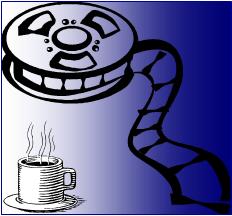

|
 |
The Third Man
|
Please go to the new Coffee Coaster site implemented more gracefully in Wordpress. This page: http://brianrwright.com/CoffeeCoasterBlog/?p=3996 |
Joseph Cotten ... Holly Martins
Alida Valli ... Anna Schmidt
Orson Welles ... Harry Lime
Trevor Howard ... Major Calloway
Bernard Lee ... Sergeant Paine
Paul Hörbiger ... Karl
Ernst Deutsch ... 'Baron' Kurtz
Siegfried Breuer ... Popescu
Erich Ponto ... Dr. Winkel
Calloway: Go home Martins, like a sensible chap. You don't know what you're mixing in, get the next plane.
Martins: As soon as I get to the bottom of this, I'll get the next plane.
Calloway: Death's at the bottom of everything, Martins. Leave death to the professionals.
Martins: Mind if I use that line in my next Western?
Anna Schmidt: A person doesn't change just because you find out more.
Amazing I'd never seen this highly artful, black and white film, because it actually has a bit of a political message, set as it is in immediate post World War II Vienna, Austria. The city was divided into four separately policed zones—US, Britain, France, Russia—mainly to accommodate the diplomatic niceties extended to the Soviets. Hint: Nobody wanted to be in the Russian zone.[1] It was quite common for Germans to forge their identity papers so that they would appear to live in districts under responsibility of the Western powers.
Anna Schmidt (Alida Valli) is one such individual of possibly forged residency, who has long been the stage-actress moll of one Harry Lime (Orson Welles). Harry has a reputation in Vienna as a black marketeer. He is an American who back in the States was friends with Holly Martins (Joseph Cotton), a tabloid fiction writer with a small, though growing, worldwide audience. Responding to a standing invitation from Lime, Holly comes to visit him in Vienna, in the British section. When Holly arrives the police chief Major Calloway (Trevor Howard) informs him that Lime has been killed in a freak traffic accident.
"Wait a minute, how can this be?" thinks Martins. Playing the nosey American who can't leave well enough alone, Martins goes to the scene of the accident and starts asking questions of the few residents in the area who may have seen something that day. Sure enough, something is fishy, witnesses report seeing different things, different persons, a person driving the vehicle who was known to Lime, and so on. A 'business associate' of Lime's visits Martins and sounds like Major Calloway: why not just leave Vienna and let it go, no sense trying to unravel these Silly Europeans. But Martins is stubborn and decides to contact Lime's purported girlfriend, Anna, who is playing in a Mozart opera.
This is sort of where the sets begin to stand out for the casual modern viewer, especially a viewer who may be into the fine arts. Vienna is such a marvel of culture, seemingly with a museum and opera house on every block. The building where Martins finds Anna performing is, well, like something out of the movies. Only it's obviously the real thing, and I'll bet you dollars to donuts it was built more than 200 years ago.
Anna is quite a beauty, not to mention a modest talent in the local theater group. As Harry watches her carry on a not-too-challenging part, this writer of dimestore Westerns and sundry detective stories is nonetheless captivated by her aura. [And, no doubt, he's pretty hot for her bod, too.] He arranges to run into her backstage following the performance. Anna has quite the personality: defiantly worldly wise yet strangely and softly devoted to her deceased lover, Harry Lime. She resists Holly's questions, is even skeptical of his identity for a while; further, she consistently calls Holly Harry, even as he (often) reminds her of his real name. I love the character Anna, and I cannot help thinking of her as Rand's heroine Kira Argounova in Ayn Rand's great novel and movie, We the Living.[2]
After a while, Anna does warm up to Holly. But only to a point. She is reluctant to help dredge up any more interest in Harry's demise. And as someone who stands to lose everything—by having her identity exposed as not belonging in the British sector of Vienna, rather the Russian sector—you can understand her thinking on that score. But a combination of curiosity and loyalty drive her to accompany Holly and help him translate, to move his investigation along, while ideally keeping him at arm's length... both politically and romantically. You can see she does become fond of Martins "that way," which adds to the suspense of the story.
Obviously, I don't want to reveal too much more of the plot, except to state that Holly gets closest to the truth when he learns from one of the witnesses (who has not been scared away [by something or someone who doesn't want the truth known]) that some witnesses report seeing a "third man" during the incident where Harry Lime was struck by the vehicle, then moved to the side of the road, etc. Also, the people who prefer to leave sleeping dogs lie get rougher and more ominous with anyone who assists in the private investigation of this buttinski Americano.
That's another word that can be used to characterize the story: ominous. And the filmmakers' art is showcased, especially with the black and white cinematography. Angles and shadows and light, oh my! The filming truly underscores the mystery and danger lurking about. You're not even sure the British coppers—Calloway and his somewhat comic-relief assistant—are true blue. As for Lime, if his death wasn't an accident, who had him killed and why?
The features for my DVD have director Peter Bogdanovich giving his opinion of "one of the best American film noir's in history." He comments that Carol Reed, the director, was, for this film, often asserted to be borrowing from Orson Welles... who is, after all, an uncredited screenplay writer. Well, it's interesting to look at Reed's oeuvre; he was born in 1906 and his credits extend from the early 1930s. He seems to like to turn novels into movies, and is particularly fond of Graham Greene's novels. The person I watched The Third Man with said this seemed just like an Orson Welles movie. [I haven't seen too many of Welles' movies.]
So that's the gist. As I mentioned, there is a bit of a political angle to the movie, namely the unwillingness of the West to stand up to the Soviet butchers, who were all set to inflict serial genocide following the Nazi atrocities. How could that happen? Greene suggests that the Russians are murderous brutes, but with too light a hand. That's why the character of Anna is so vital to human context. You can see in her eyes the intelligence about what lies in store for her without protection of the wheeling and dealing of a Harry Lime or the shielding by the more pedestrian and fundamentally uncaring police forces of the West. With respect to such powers, a well-meaning American guy may not be much of a protector.
Great performances all around, great authentic settings, great classic.
[1] The littlest known story of the aftermath of WWII is how Churchill and Roosevelt sold several million German civilians into death and dispossession, most of them into the USSR Gulag. Ref. A Terrible Revenge.
[2] Valli played Kira in the movie, We the Living (1942), the rights for which were stolen by the Italian fascists. She was a well-known actress in the 1930s through the 1950s, some considering her the next Greta Garbo. She is marvelous as Kira... and as Anna.
###
2010 December 08
Copyright © Brian Wright | The Coffee Coaster™
The Third Man | Joseph Cotton | Orson Welles | Post War Film Noir
 |
drug testing kits |
|||
| |